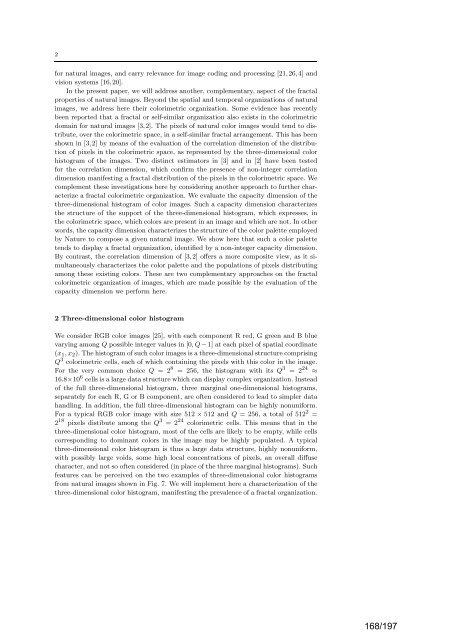a la physique de l'information - Lisa - Université d'Angers
a la physique de l'information - Lisa - Université d'Angers
a la physique de l'information - Lisa - Université d'Angers
Create successful ePaper yourself
Turn your PDF publications into a flip-book with our unique Google optimized e-Paper software.
2<br />
for natural images, and carry relevance for image coding and processing [21,26,4] and<br />
vision systems [16,20].<br />
In the present paper, we will address another, complementary, aspect of the fractal<br />
properties of natural images. Beyond the spatial and temporal organizations of natural<br />
images, we address here their colorimetric organization. Some evi<strong>de</strong>nce has recently<br />
been reported that a fractal or self-simi<strong>la</strong>r organization also exists in the colorimetric<br />
domain for natural images [3,2]. The pixels of natural color images would tend to distribute,<br />
over the colorimetric space, in a self-simi<strong>la</strong>r fractal arrangement. This has been<br />
shown in [3,2] by means of the evaluation of the corre<strong>la</strong>tion dimension of the distribution<br />
of pixels in the colorimetric space, as represented by the three-dimensional color<br />
histogram of the images. Two distinct estimators in [3] and in [2] have been tested<br />
for the corre<strong>la</strong>tion dimension, which confirm the presence of non-integer corre<strong>la</strong>tion<br />
dimension manifesting a fractal distribution of the pixels in the colorimetric space. We<br />
complement these investigations here by consi<strong>de</strong>ring another approach to further characterize<br />
a fractal colorimetric organization. We evaluate the capacity dimension of the<br />
three-dimensional histogram of color images. Such a capacity dimension characterizes<br />
the structure of the support of the three-dimensional histogram, which expresses, in<br />
the colorimetric space, which colors are present in an image and which are not. In other<br />
words, the capacity dimension characterizes the structure of the color palette employed<br />
by Nature to compose a given natural image. We show here that such a color palette<br />
tends to disp<strong>la</strong>y a fractal organization, i<strong>de</strong>ntified by a non-integer capacity dimension.<br />
By contrast, the corre<strong>la</strong>tion dimension of [3,2] offers a more composite view, as it simultaneously<br />
characterizes the color palette and the popu<strong>la</strong>tions of pixels distributing<br />
among these existing colors. These are two complementary approaches on the fractal<br />
colorimetric organization of images, which are ma<strong>de</strong> possible by the evaluation of the<br />
capacity dimension we perform here.<br />
2 Three-dimensional color histogram<br />
We consi<strong>de</strong>r RGB color images [25], with each component R red, G green and B blue<br />
varying among Q possible integer values in [0, Q −1] at each pixel of spatial coordinate<br />
(x1, x2). The histogram of such color images is a three-dimensional structure comprising<br />
Q 3 colorimetric cells, each of which containing the pixels with this color in the image.<br />
For the very common choice Q = 2 8 = 256, the histogram with its Q 3 = 2 24 ≈<br />
16.8×10 6 cells is a <strong>la</strong>rge data structure which can disp<strong>la</strong>y complex organization. Instead<br />
of the full three-dimensional histogram, three marginal one-dimensional histograms,<br />
separately for each R, G or B component, are often consi<strong>de</strong>red to lead to simpler data<br />
handling. In addition, the full three-dimensional histogram can be highly nonuniform.<br />
For a typical RGB color image with size 512 × 512 and Q = 256, a total of 512 2 =<br />
2 18 pixels distibute among the Q 3 = 2 24 colorimetric cells. This means that in the<br />
three-dimensional color histogram, most of the cells are likely to be empty, while cells<br />
corresponding to dominant colors in the image may be highly popu<strong>la</strong>ted. A typical<br />
three-dimensional color histogram is thus a <strong>la</strong>rge data structure, highly nonuniform,<br />
with possibly <strong>la</strong>rge voids, some high local concentrations of pixels, an overall diffuse<br />
character, and not so often consi<strong>de</strong>red (in p<strong>la</strong>ce of the three marginal histograms). Such<br />
features can be perceived on the two examples of three-dimensional color histograms<br />
from natural images shown in Fig. 7. We will implement here a characterization of the<br />
three-dimensional color histogram, manifesting the prevalence of a fractal organization.<br />
168/197


